Silpancho
Every Friday after sunset, a house on my block would bring a bare lightbuld to hang outside of their door and a sign that said silpancho made out of a flattened lard can. When I was very little in Cochabamba, my street was a dead end and this silpancho light was the only illumination on the street. My mom would send us out with a plate to buy a silpancho from the lady selling them and we’d take it home to share among the five of us. People would sell silpancho in this way to earn a little extra money and it was so delicious.
I moved to Maine in 2009 and the first thing that I missed was Bolivian food. The first Bolivian recipe that I made for my in-laws was Silpancho and they loved it. So now, silpancho is the favorite dish of both of my families from Maine and Bolivia.
serves 4
cooking time: 1 hr
1 c. white rice
3 yukon gold potatoes
1 small green pepper, med. diced
1/2 small red onion, med. diced
1 tomato, medium diced
2 tsp vinegar
2 tsp vegetable oil
1 lb. ground beef (with the least fat content possible, ideally 90% or more lean, buffalo meat is also delicious)
salt
pepper
3/4 c. breadcrumbs
handful of Quillquiña leaves (or cilantro)
canola oil
First, get 1 cup of rice with 2 cups of water heating on the stove. Also put 3 whole potatoes on to boil for about 10 minutes. Once cool enough to touch, you’ll slice them like this (notice the insides are still raw). You’re going to finish cooking them in a frying pan.
Massage salt and pepper into the ground beef with your hands. Then you divide the ground beef into balls the size of limes. Sprinkle ground pepper onto a of a pile of breadcrumbs and then roll the beef in the bread crumbs to give it a light coating.
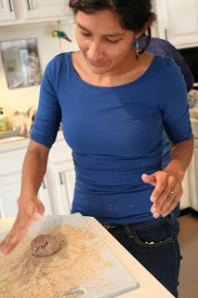
Coat each side the meat with breadcrumbs and roll flat with a rolling pin on top of the breadcrumbs, flipping the meat over whenever it starts to stick.

The final thickness should be like a crepe. Roll each meatball out into a sheet and stack the rolled meat sheets on a plate. Pan sear each on medium high, flipping them when you could see raw pink start to turn brown.
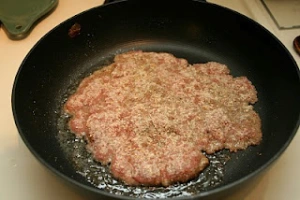
Stack each finished meat sheet on a plate, and then fry eggs individually and brown the potato rounds.
Top the dish with the salad of tomato, red onion, and green pepper. Bright, fresh, and crunchy, it breaks up the richness of the meat, eggs and potatoes. The dressing is equal parts vinegar and oil, plus generous salt.
To put the plate together, put potatoes at the bottom, then rice, the beef, egg and then the salad.
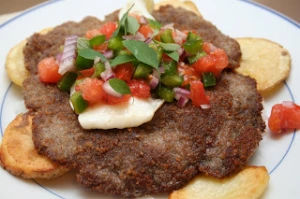
Prepare a nice llajwa (spicy sauce) to go with it!
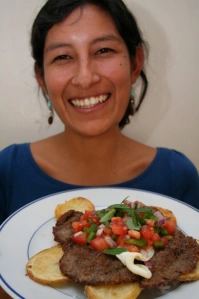
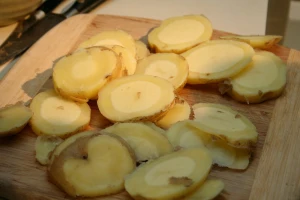

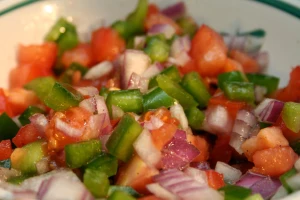
looks excellent. I have never made mine with ground meat before. I might have to try that. I’ve grown my own quilquina before, but it’s flavor is very strong. It was vetoed in my house. 😦 Happy to find your blog. I enjoy cooking Bolivian food as well since my mom is from Cochabamba!
Looks amazing. I’m currently writing an around the world food blog: eaternational.wordpress.com and plan to use your recipe for Bolivia!
Great! I like your blog good luck with the recipe let me know if you have questions about the recipe. Buen Provecho! 🙂
I had never made my sillpancho with ground meat before, ( I am from Cochabamba) I just made it, it is delicious and much easier to make. Thanks
so happy to have found your blog!! i can’t wait to recreate my summer in la paz at home in my kitchen now. i wish bolivian food would be found more places. so hard to find outside of Miami and the NoVa/DC area! however i have heard of a frozen saltenas from Goya available in the local market – do you have any more suggestions of where to find Bolivian ingredients. maybe online somewhere?
Thank you. I try a new dish from anywhere in the world each year on my BIRTHDAY. Bolivia is my choice this year. I will make this to share with others, definitely. But will try it at a restaurant I went to last week,since all we had there was tea n tres leches.
Happy Birthday! Feliz Cumpleaños! Hope you all enjoy it!
Hi Rommy;
Thank you so much for posting this. I am from La Paz Bolivia and definitely miss having good Bolivian food. I made this today and it was a hit with my husband and son.
Tomorrow I will be making Puchero de Carnaval 🙂
Silpancho is a great meal. Unfortunately it is the ONLY good Bolivian food, at least in my experience of Cochabamba, Santa Cruz and La Paz.